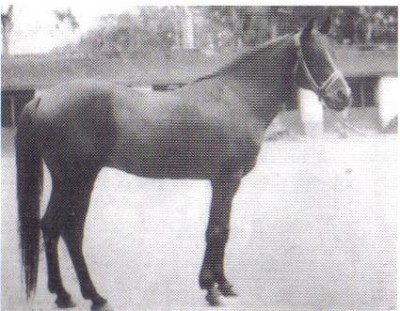“Nasr, a racehorse”
Nasr, the chestnut [January 23rd: Sporthorse-data lists hims as “brown”, and the French studbook as “bay”] horse pictured below was a desert-bred stallion that was imported to the Tunisian stud of Sidi Thabet in the 1920s. He was imported from Egypt, where he’d had a good career as a racehorse. French masterbreeder Robert Mauvy, who knew Nasr, referred to him as “the prestigious imported horse Nasr” in one of his books.
MIchael Bowling tells me that the Egyptian Royal Agricultural Society (RAS) used a desert bred racehorse by the name of Nasr as a stallion in the 1920s, and that this horse was subsequently exported to Tunisia. He also tells me this horse is the reason why the other more famous *Nasr (Rabdan El Azrak x Bint Yemama) was renamed “Manial”, when he was raced by Prince Mohammed Ali Tewfik before being exported to the USA.
If so, then it seems like the chestnut horse in the picture is the “Nasr, a racehorse” of one of the early EAO studbooks. He left many descendents in Tunisia, and in France, of which Mauvy’s Moulouki is one. Moulouki’s maternal granddam Arabelle is a granddaughter of this Nasr. [Jan 23rd update: He is also in the pedigree of Irmak]

He’s very nicely proportioned.
He could come and grace my barn any time.
With some luck he could have been like Mashaan, Nabras, El Deree or El Nasser today.. but maybe it was better this way.. I also wonder if he qualifies as “Straight Egyptian”..
Thanks Edouard for posting the picture of this Nasr. I always wondered about him. I looked him up on the Datasource and see they list him as straight Egyptian, probably because he did bred on in Egyptian lines briefly. This Nasr does not appear in the root stallions section of the RAS stud book but does appear in the studbook where he is the sire of certain get such as Bint Bint Radia etc., where he is referred to as “a Race Horse”. He sired 5 get at the RAS, all were foaled in 1927 but no other information about him is found in the RAS stud book. His 3 sons did not produce in Egypt. His two daughters produced a son each in Egypt but the line ends there. The Datasource shows a French Nasr as a 1918 bay stallion. It indicates that he was imported but no travel data is given. This could be the Egyptian stallion since the first foaling dates for his get in France are 1929. He is listed as the sire of 45 get in France in the DataSource.
He looked chestnut to me in the picture, so I mentioned him as chestnut, but he could be bay as well. The horse in Tunisian pedigrees is certainly bay. Do we know the color of the sire of Bint Bint Radia and the other 4 RAS horses?
By the way, Tunisia, Algeria and Morocco had their horses registered in the French studbook until their independence (1950s) from France. So, while Nasr is listed as the sire of 45 get in France, they were all born in Tunisia.
Edouard, I could not find any reference for the coat color of “Nasr, a race horse” in the RAS stud book. However the dates I mention above make him most likely the same horse registered in SBFAR as a 1918 bay. Horses of the “washy bay” or “honey bay” color might look chestnut in black and white photos. Years ago we bought Anchor Hill Jewel in foal to Al Metrabbi and she produced a filly that we were not sure if it was bay or chestnut. It took almost two years before the dark color on the legs and mane turned from a dark liver color to black. Mrs. Atkinson told us to register the filly as bay because eventually she would look bay. She said that some of Al Metrabbi’s foals would go through this slow change to bay. Tom McNair later told me that in his experience some Egyptians will do this and that in Egypt they called it “Marward”.
est ce que tu veux dire qu’il y’a deux NASR car en tunisie certain eleveurs conteste les origines de ESMET ALI descendant de NASR ,est il possible que le véritable NASR ne soit pas venu en tunisie ou quoi ?
Non, il n’y a eu qu’un seul Nasr qui soit venu en Tunisie. La discussion ici porte sur la possibilite que ce Nasr-la soit le meme qu’un autre Nasr qui ait couru et sailli en Egypte avant etre envoye en Tunisie en 1928 . Il semble bien que ce soient les memes chevaux.
La raison pour laquelle certains eleveurs Tunisiens doutent d’Esmet Ali est autre. Elle n’a rien a voir avec Nasr.
Nasr a Racehorse
As per the “Societe des course hippiques de Tunisie”:
Nasr Born 1918 1.50m bay,Saklawi,imported from Egypt
Sire: Ghatoun imported fro Nejd
Dam: as Saklawia from the Fedaan
Here you go, we have the final confirmation that this is the same horse. Thank you.